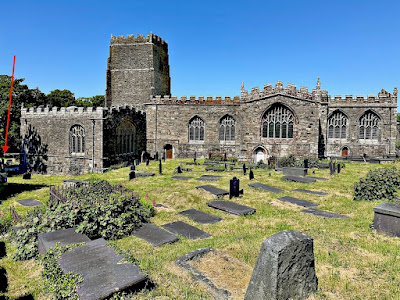my body opened at the knowledge of existence
and of being, confused and diffused
my body trembled and sighed
to a forgotten song
not yet a fugitive of music
I knew the place of time
and the time of place
—Alejandra Pizarnik
Standing next to this 10th century granite slab-type sundial time I wonder... how does time matter, or rather appear? And so, this musing: time matters. With a gnomon (rod-pointer) extending from the drilled hole, the sun’s shadow would mark the canonical hours as it crossed the linear incisings.
This sundial, a slab-dial with a cross of western Celtic pattern at its head, once marked the monastic daily cycle. The linear incisings, some still visible, marked the canonical hours, the divisions of the day for fixed times of prayers, often the three-hour intervals of religious services appointed by canon law. Time plays on and on as many come and go.
Located in Clynnog Fawr, North Wales, it is a type also known in Ireland, but thought to be unique in Wales and is a Grade II listed monument. According to Cadw, the Welsh Government’s historic environment service, “probably still standing in its original location on a major religious site.” Perhaps, and No. And yes.
H. Harold Hughes in a 1931 Miscellanea “An Ancient Sun-Dial at Clynnog” notes: Fenton writes (in Tours in Wales, 1813) that from Clynnog, "In our way to Carnarvon about a mile on our road, observe a long stone of a curious grit, with a cross in a circle on one end which appears to have been a tomb or shaft of a cross.”' Hughes in 1931 learned the stone-slab was used a footbridge and later moved to a farm “to support milk-pails.” His group helped the Vicar of San Beuno Church relocate the sundial-slab to where they believed it belonged: next to the chapel in the churchyard. With this stone I gaze at the ancient churchyard, populated with inscribed slate stones, some for the ancient monks. Imagining,
for a thousand years in place at the corner of the St Beuno Chapel and
the 16th century St Beuno Church. And somewhere near a lost 7th century monastery.
The free-standing sundial is my height. Ambiguously Cadw notes: “approximately 2m high (reduced by c30cm).” The “reduced” is not explained. From the rear view the top appears rough. Was there more to the cross? What does Time not tell?
Hughes, a Bangor architect, doesn’t clarify, but carefully measures the stone and notes: “The full length of the stone is 9 feet 3 inches, but 2 feet 9 inches is buried below the ground surface.” Hughes concludes: “The Clynnog dial appears to be unique as far as Wales is concerned. I have little hesitation in assigning its date to a pre-Norman period.”
—Appreciation
to Ashley Batten, MA, MCIfA, Regional Inspector of Ancient Monuments
and Archaeology North Wales, for his helpful advice after we crossed
paths one fine morning in Penmaenmawr.
—Photos May 2025. Red arrow, left in above photo of St Beuno Church, indicates the Sundial next to the Chapel. (click to enlarge)
—Alejandra Pizarnik, from Extracting the Stone of Madness (translated by Yvette Siegert, 2016).
—H. Henry Hughes in a 1931 Miscellanea “An Ancient Sun-Dial at Clynnog” in Archaeologia Cambrensis.
—Cadw. Full Report for listed Buildings: Sundial in the churchyard of the Church of St Beuno. https://cadw.gov.wales/
—https://en.wikipedia.org/wiki/Clynnog_Fawr
—Speculative binaries: Marcia Bjornerud, in Timefulness, distinguishes Time as something that simply marches on — chronos — and Time that is defined within a narrative — kairos. Similarly, Stephen Jay Gould shapes a geologic dynamic as: Time’s Arrow, Time’s Cycle.
CODA
And, above all, to look on innocently. As if nothing were happening, which is true. —Alejandra Pizarnik
Another Tale of Time in Clynnog Fawr






.jpeg)








